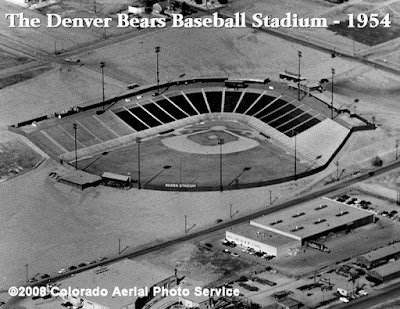Hello friends!
Today's stadium was short-lived in MLB, but it was also used in Minor League Baseball and the NFL.
Of course, it's Mile High Stadium
Fun fact.. TCDB only has one card listed under Mile High Stadium's checklist. It reads as two because one is a parallel.. But there are two distinct cards.
1993 Triple Play has a card of Mile High. The one listed on TCDB is the 1994 Score and Gold Rush parallel.
Anyway..
Mile High was originally known as Bears Stadium and was built in 1948 for the Denver Bears minor league baseball team.
The stadium was built on the site of a former landfill and consisted of a single 18000 seat grandstand.
Bob Howsam, the person behind getting Bears Stadium built, was part of the group trying to get a third Major League going in the late 50s. That league would have been the Continental League. If I recall, it's how the Mets came into being, as the CL was going to place a team in New York, so MLB awarded the Mets expansion franchise. However, that's for another episode..
Howsam was told that he would need to expand the stadium to be MLB worthy, so expansions started. Because Denver was not given a team in that round of expansion Howsam was left with a lot of debt. His solution was to try to get into the AFL.
The expansion done at the time was to triple deck the west sideline. Debt forced Howsam to sell in 1961. In 1966, Denver was told that in order to be part of the AFL-NFL merger, the stadium needed to be upgraded to 50 000 seats. The city of Denver bought the stadium in 1968 and renamed the place Mile High Stadium.
The Broncos kept selling out their games in the 70s, causing more and more expansions. The largest of them is the set taking place form 1975-1977 where the capacity was raised to 75000 by expanding the the upper deck along the north side and building moveable grandstands for the east side.
This meant the stadium could be in a horseshoe shape for football and the usual configuration for baseball.
The moveable structure was 450 feet long and 200 feet wide and weighed 9 million pounds. Movement was done through hydraulics. Water bearings would be filled with water, lifting the grandstand up. A sheet of water 1/3 of an inch thick formed, allowing engineers to use hydraulic rams pushed the stands at a rate of two feet per minute. The average time to move the stands was 6 hours..
The Rockies began play in 1993. They blew attendance records out of the water because fams were excited for MLB and the team offered low ticket prices. The Rockies would only stay here until 1995 when they moved to Coors Field, but people made their way out to the Park in those early days.
After the Rockies moved to Coors, the Broncos remained as tenants here until 2000. After moving to their new home, Empower Field, Mile High was demolished and the site turned into a parking lot for the new stadium. A miniature Mile High sits on site as well.
So.. Tenants of this place throughout its history:
Denver Bears (WL) 1948-1954
Denver Bears/Zephyrs (AA/PCL) 1955-1992
Denver Broncos (AFL-NFL) 1960-2000
Denver Dynamos (NASL) 1974-1975
Colorado Caribous (NASL) 1978
Denver Gold (USFL) 1983-1985
Colorado Rockies (MLB) 1993-1994
Colorado Rapids (MLS) 1996-2001




.jpg)

I love those old stadiums that they just kept adding to. So cool.
ReplyDeleteSome look natural. Some look like they were slapped together with duct tape.
DeleteThey are fun to research for sure
Interesting history there!
ReplyDeleteWhen I was a kid... I thought this was one of the coolest stadium names in sports. Kinda surprised there are only three trading cards for it.
ReplyDeleteLater Bob became the man who fired Sparky Anderson when he was the GM for the Cincinnati Reds
ReplyDeleteI had no idea that this stadium had a such a history!
ReplyDeleteI love reactions like this. When I started the Stadium series I was hoping to give info that maybe wasn't well known.
DeleteI mean I'm still keeping the focus Canadian on here. Just something different..